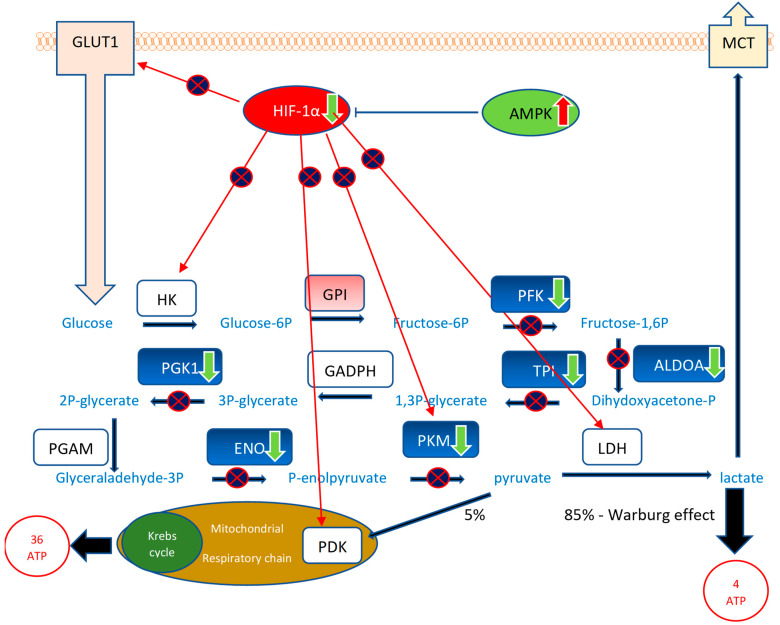Figure 6.
The effect of RG–RS on glycolysis: RG–RS strongly downregulates the expression of 8 genes encoding eight enzymes of the glucose metabolic pathway, significantly inhibits the HIF-1α signaling pathway, a master regulator of glycolysis, and activates antitumor monophosphate-activated protein kinase (AMPK) suggesting substantial inhibition of the conversion of glucose into lactate (Warburg effect) in cancer that is crucial for proliferation and survival of tumor cells. Downregulated genes are shown in the green color, corresponding enzymes in the blue color: the neuron-specific enolase (NSE) ENO1 gene (−2562-fold change), phosphoglycerate kinase 1 PGK1 gene (−1426-fold change), the pyruvate kinase PKM gene (−1094-fold change), the aldolase ALDOA gene (−855-fold change), the triose phosphate isomerase TPI gene (−810-fold change), phosphofructokinase, encoded by the PFK gene (−730-fold change). HKs—hexokinases HK1, HK2, HK3, HK4, which are encoded by the HK1, HK2, HK3, and HK4 genes; GPI—glucose-6-phosphate isomerase encoded by the GPI gene (+372-fold change); GAPDH: glyceraldehyde 3-phosphate dehydrogenase, encoded by the GAPDH gene; PGAM—phosphoglycerate mutase, encoded by the PGAM gene; LDH—lactate dehydrogenases; which are encoded by LDHA and LDHB genes; GLUT1—glucose transporting proteins encoded by the SLC2 gene; MCTs: lactate transporters encoded by the SLC16 gene. Tumor suppressors are shown in green, and oncogenes are in red. RG–RS inhibits (p > 1.3; z 1.5, Supplement Table S6) the oncogenic Hypoxia-inducible factor-1 (HIF-1α) and activates (p > 1.3; z—1.7, Supplement Table S6) tumor suppressor adenosine monophosphate-activated protein kinase (AMPK) signaling pathways.

